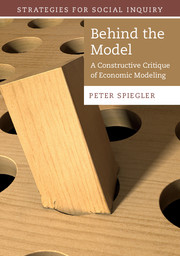Book contents
- Frontmatter
- Dedication
- Contents
- Acknowledgments
- Introduction
- Part I A constructive critique of common modeling practice
- 1 Models and modeling
- 2 The use of mathematics in theoretical modeling
- 3 The use of mathematics in empirical modeling
- Part II The critique applied
- Part III A reform proposal
- Conclusion
- References
- Index
1 - Models and modeling
from Part I - A constructive critique of common modeling practice
Published online by Cambridge University Press: 05 December 2015
- Frontmatter
- Dedication
- Contents
- Acknowledgments
- Introduction
- Part I A constructive critique of common modeling practice
- 1 Models and modeling
- 2 The use of mathematics in theoretical modeling
- 3 The use of mathematics in empirical modeling
- Part II The critique applied
- Part III A reform proposal
- Conclusion
- References
- Index
Summary
Economics, today, is a model-based science. Choose an article at random from one of the discipline's top journals, and you will almost certainly find a mathematical model acting – explicitly or implicitly – as the engine of the analysis. This is not coincidental. Economists are trained to see the economy through the lens of models. In Ph.D. programs, macroeconomic theory is taught through various versions of the Solow Growth model, riffs on the Friedman or Modigliani consumption model, the IS-LM interpretation of Keynesian theory, real business cycle and New Keynesian theory expressed as Dynamic Stochastic General Equilibrium models, and so on. In microeconomic theory, students are presented with Samuelsonian models of demand and utility, the Arrow–Debreu general equilibrium model, Nashian game theoretic models of strategic interaction, Akerlof and Stiglitz models of informational effects, trade theory based on the Edgeworth box, and more. The day-to-day practice of economists equally reflects this focus. Doing economics today effectively means constructing, manipulating, solving, estimating, and/or assessing mathematical models.
In light of this, it may come as a surprise to many economists that there is considerable controversy in the fields of philosophy of science and economic methodology over what models are and how they work. Indeed, one renowned scholar describes the term “model” as “surely one of the most contested in all of philosophy of science” (Godfrey-Smith 2006: 725). Accordingly, we must specify carefully what we mean by “modeling” before turning to the analysis of current economic practice. Providing that specification is the aim of this chapter.
I begin by laying out an account of modeling widely accepted by economists. Essentially, that account holds that models are hypothesis generators whose merit is and ought to be judged solely on the basis of the performance of those hypotheses in empirical testing. Since this view of models is a simplified version of that proposed by Milton Friedman (1953) in his essay “The Methodology of Positive Economics,” I call it “Friedman-lite.” I do not mean to suggest that precisely this view is held by all economists, but it is regularly appealed to when questions of the validity of economic methodology arise, and hence makes a good basis for discussion. Despite its popularity, however, it suffers from two serious shortcomings. First, it is based on an invalidly narrow conception of the aims of economic modeling.
Information
- Type
- Chapter
- Information
- Behind the ModelA Constructive Critique of Economic Modeling, pp. 13 - 43Publisher: Cambridge University PressPrint publication year: 2015
